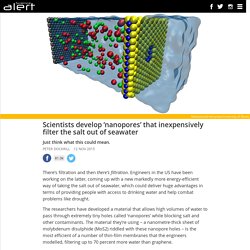

Hawaii Flips Switch on World's Largest Ocean Harvesting Clean Energy Plant. Hawaii is definitely ahead of the curve when it comes to renewable energy.

In June, the Aloha state became the first state to mandate that all of its electricity come from renewable sources no later than 2045. Along with other islands, its charging ahead with wind, solar and smart grid systems. But now, the state is home to the first fully closed-cycle Ocean Thermal Energy Conversion (OTEC) plant in the U.S. OTEC is “a process that can produce electricity by using the temperature difference between deep cold ocean water and warm tropical surface waters,” Makai Ocean Engineering, the company that built the plant, explains on its website. “OTEC plants pump large quantities of deep cold seawater and surface seawater to run a power cycle and produce electricity.” Watch this short video for an explanation of how it works: Pinterest. Scientists develop ‘nanopores’ that inexpensively filter the salt out of seawater. There’s filtration and then there’s filtration.

Engineers in the US have been working on the latter, coming up with a new markedly more energy-efficient way of taking the salt out of seawater, which could deliver huge advantages in terms of providing people with access to drinking water and help combat problems like drought. The researchers have developed a material that allows high volumes of water to pass through extremely tiny holes called ‘nanopores’ while blocking salt and other contaminants. The material they’re using – a nanometre-thick sheet of molybdenum disulphide (MoS2) riddled with these nanopore holes – is the most efficient of a number of thin-film membranes that the engineers modelled, filtering up to 70 percent more water than graphene.
“Even though we have a lot of water on this planet, there is very little that is drinkable,” said Narayana Aluru, a professor of mechanical science and engineering at the University of Illinois and leader of the study. David Wyatt – Google+ Just because you live in an apartment or a small house with minimal yard space doesn’t mean that you can’t grow your own food.

For that matter, you may even be able to have a few animals. Chickens or a goat or two may be a possibility right in your own yard. The important things to growing food for survival in small places are organization and creativity. We’ve gathered some tips that may help! Use Non-GMO, Non-Hybrid Seeds GMO, or genetically modified organisms, are genetically fused into some seeds in order to make the plant more disease-resistant. You can order seeds that have been tested and are guaranteed to be non-GMO. Likewise, don’t use hybrid seeds; they aren’t stable. The problem, though, is that only the first generation will definitely have those traits so you can’t use the seeds from them to grow identical plants.
Go with heirloom or open-pollinated, certified non-GMO seeds. Save Your Containers You’re going to need containers to plant your seeds and grow your plants in. Pinterest. Study: When Human Consumption Slows, Planet Earth Can Heal. Despite the oft-repeated claim that the recent decline in U.S. carbon emissions was due to the so-called 'fracking boom,' new research published Tuesday shows that it was the dramatic fall in consumption during the Great Recession that deserves credit for this drop.

As nations grapple with the best strategy for decreasing carbon emissions ahead of the upcoming United Nations Framework Convention on Climate Change (UNFCCC) negotiations in Paris, the report, published in the journal Nature Communications, underscores the need for communities to transition away from an economy based on endless growth and towards a more renewable energy system to stem the growing climate crisis. Between 2007 and 2013, the United States—second only to China for the title of world's top polluter—saw carbon emissions fall roughly 11 percent. Northeast Foraging: 120 Wild and Flavorful Edibles from Beach Plums to Wineberries from Timber Press.
Ask a question about fixing anything .. How cool is that. Permaculturists. The Evernote Web Clipper. Pinterest. 5 Incredibly Dangerous Weather Myths That People Actually Believe. The Science Behind How We Learn New Skills. Urban Farming, Bottle Lights and Education. Off Grid Challenges and Homestead Opportunities on Pinterest. Urban Farming, Alternative Energy and Education.